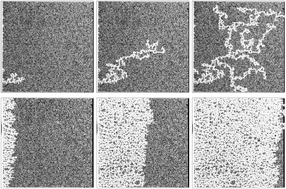Drainage in two-dimensional porous media with polymer solutions†
Abstract
We report experimental and numerical results concerning time-resolved biphasic flows in 2D model porous media involving polymer solutions. We focus on the case where a more viscous but non-Newtonian fluid displaces a wetting fluid. Similar to the Newtonian case, a transition from capillary fingering to a stable invading front is observed when the capillary number is increased. However, our results show that this transition is sharpened because of the shear-thinning behavior of the polymer solutions. At a given capillary number, the width of the invading front and correlatively the residual saturation are greater for a shear-thinning fluid than for a Newtonian one. Furthermore, we also find that the partially hydrolyzed polyacrylamide solutions investigated exhibit a rather strong slippage at low flow rates, which leads to even greater fingering. Experiments conducted in microfluidic micromodels are in quantitative agreement with time dependent non-Newtonian pore-network simulations. All of these effects are well captured by a simple model that leads to quantitative predictions of the drainage by shear-thinning fluids with slip boundary conditions.


 Please wait while we load your content...
Please wait while we load your content...